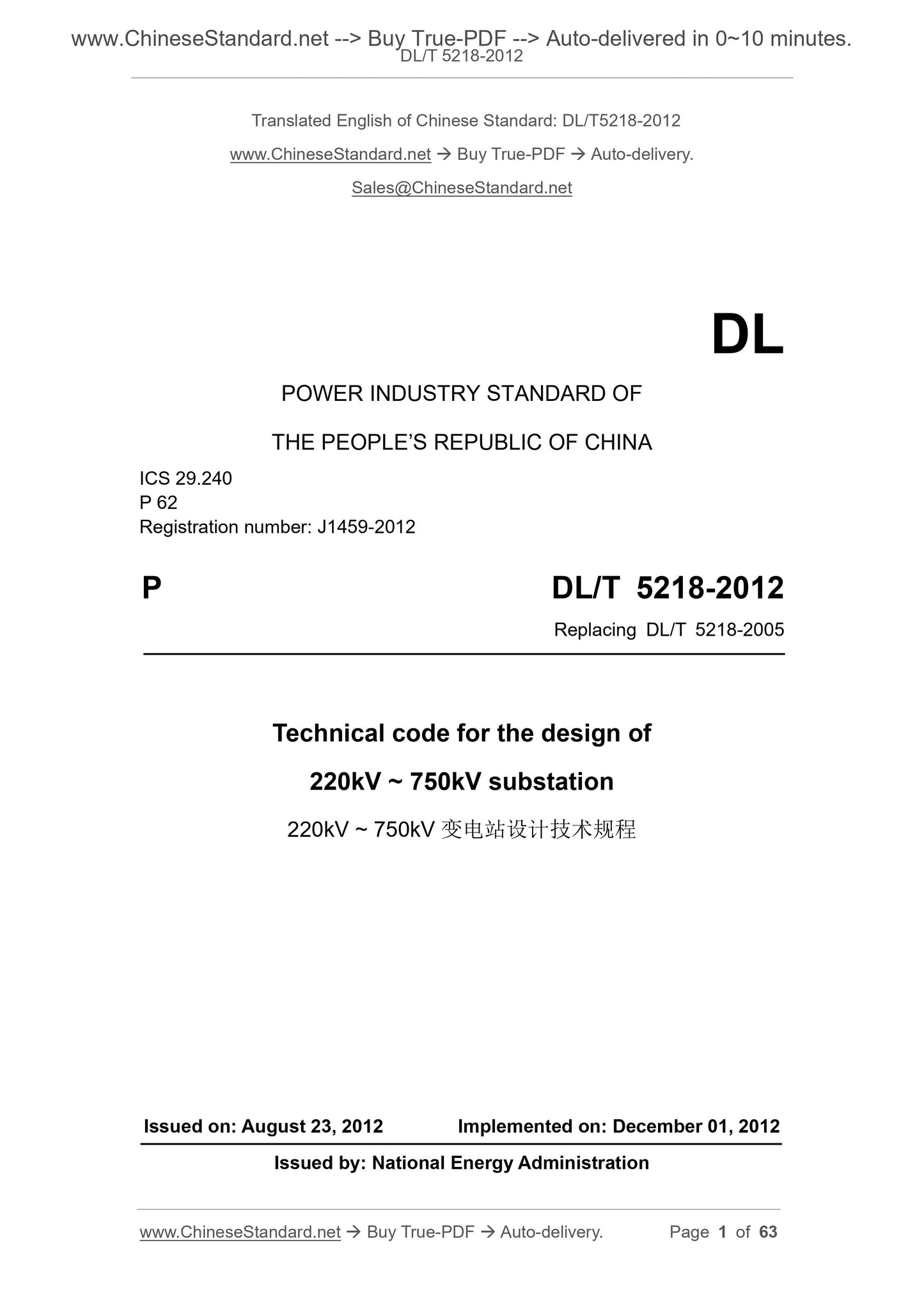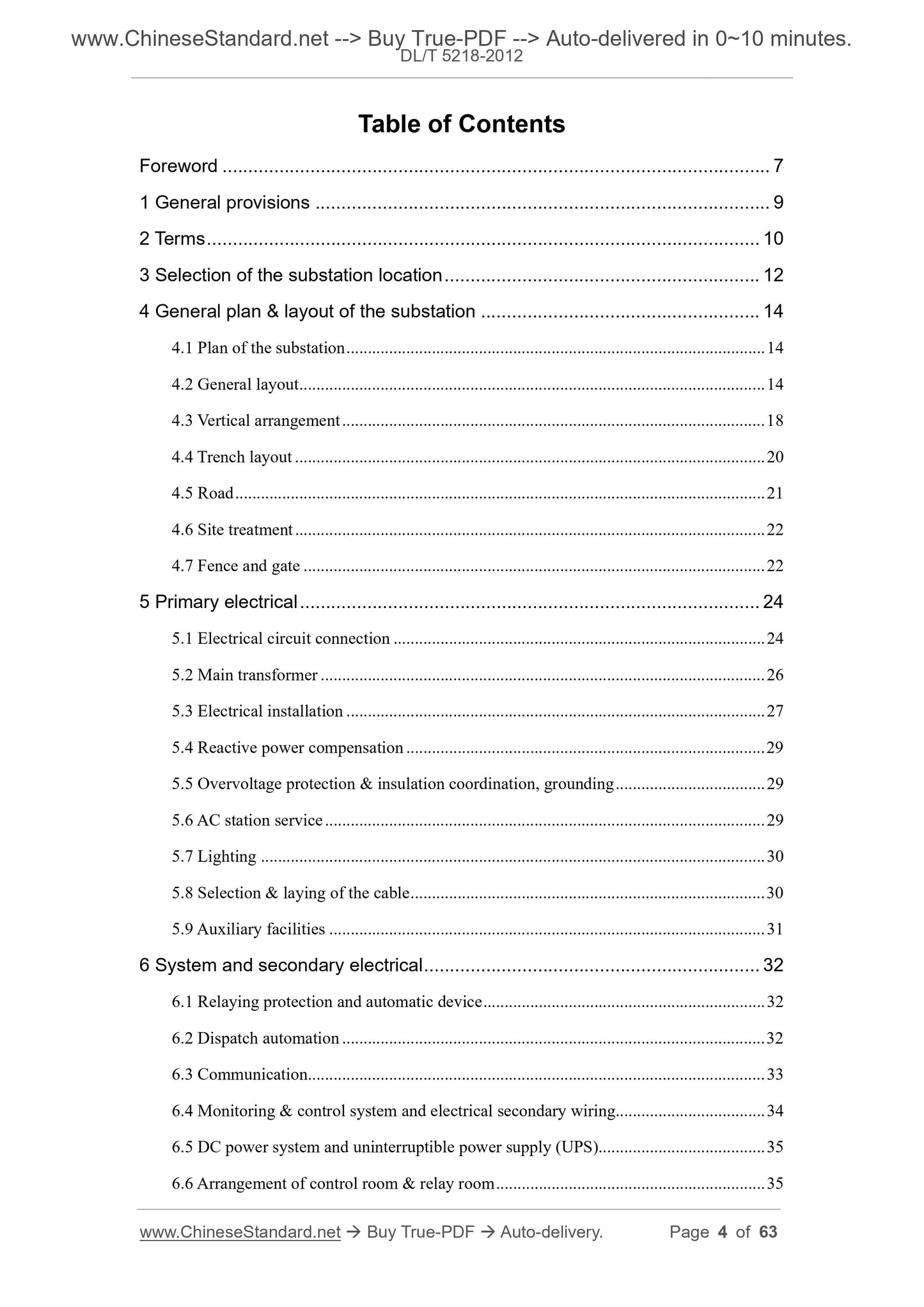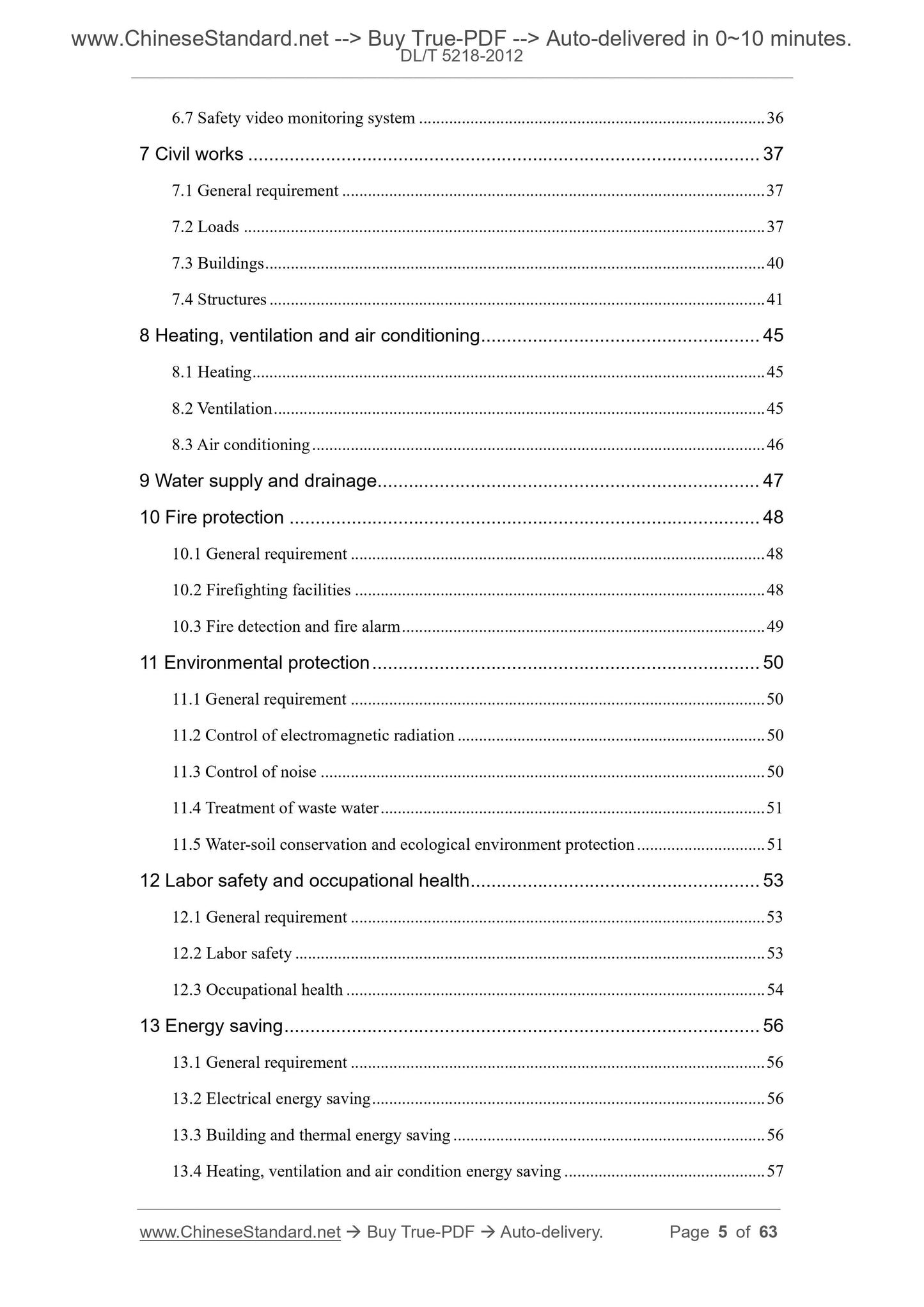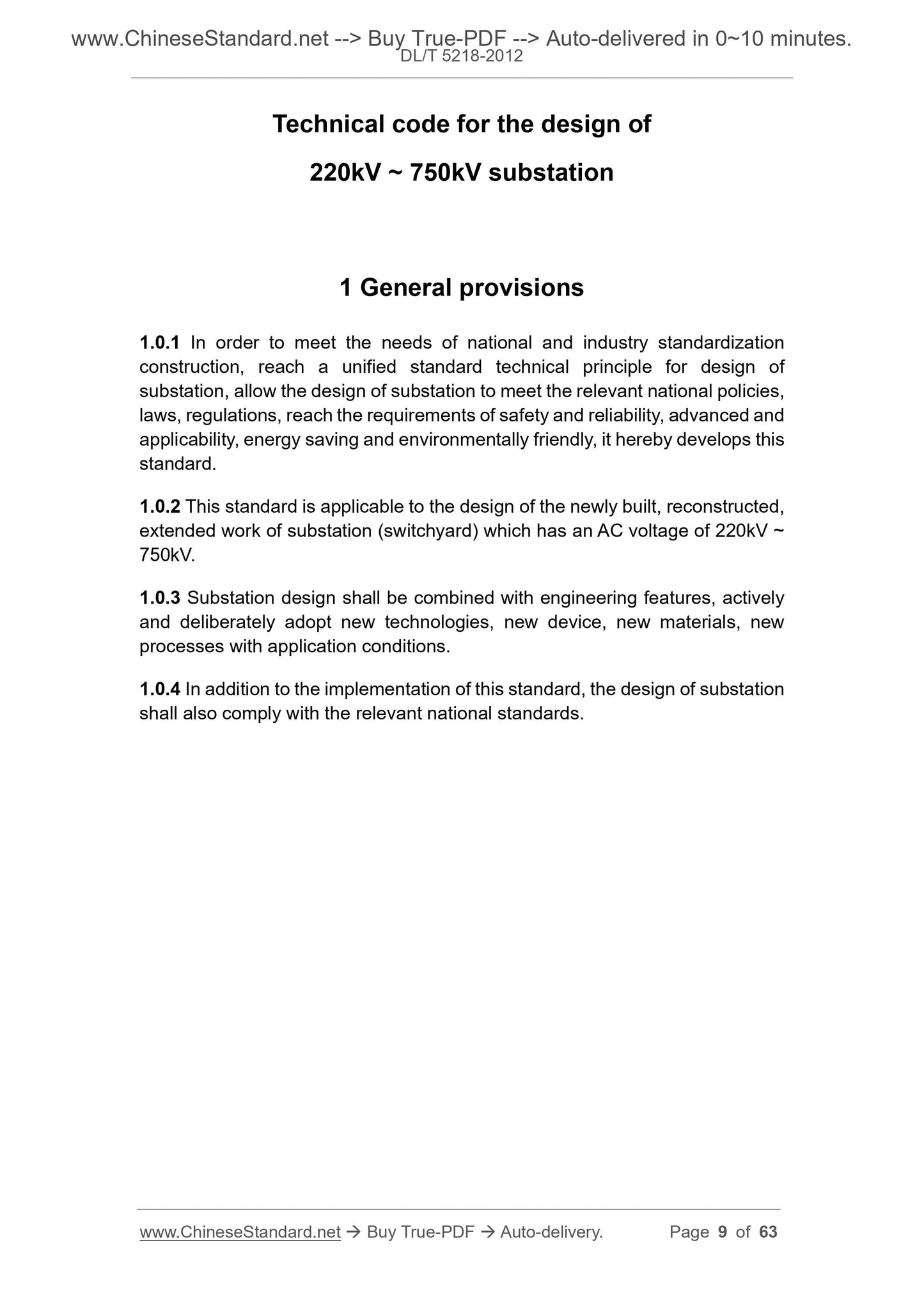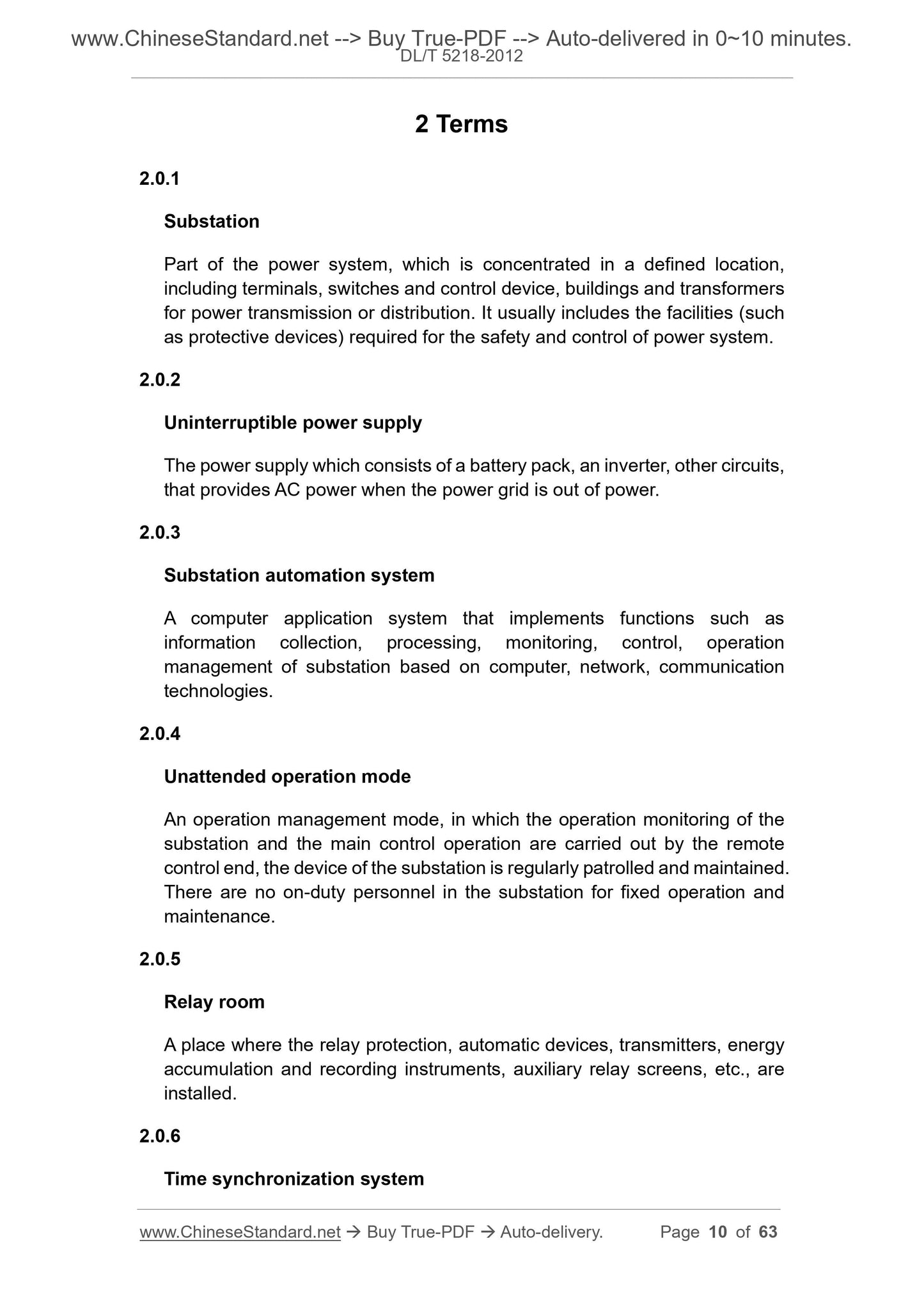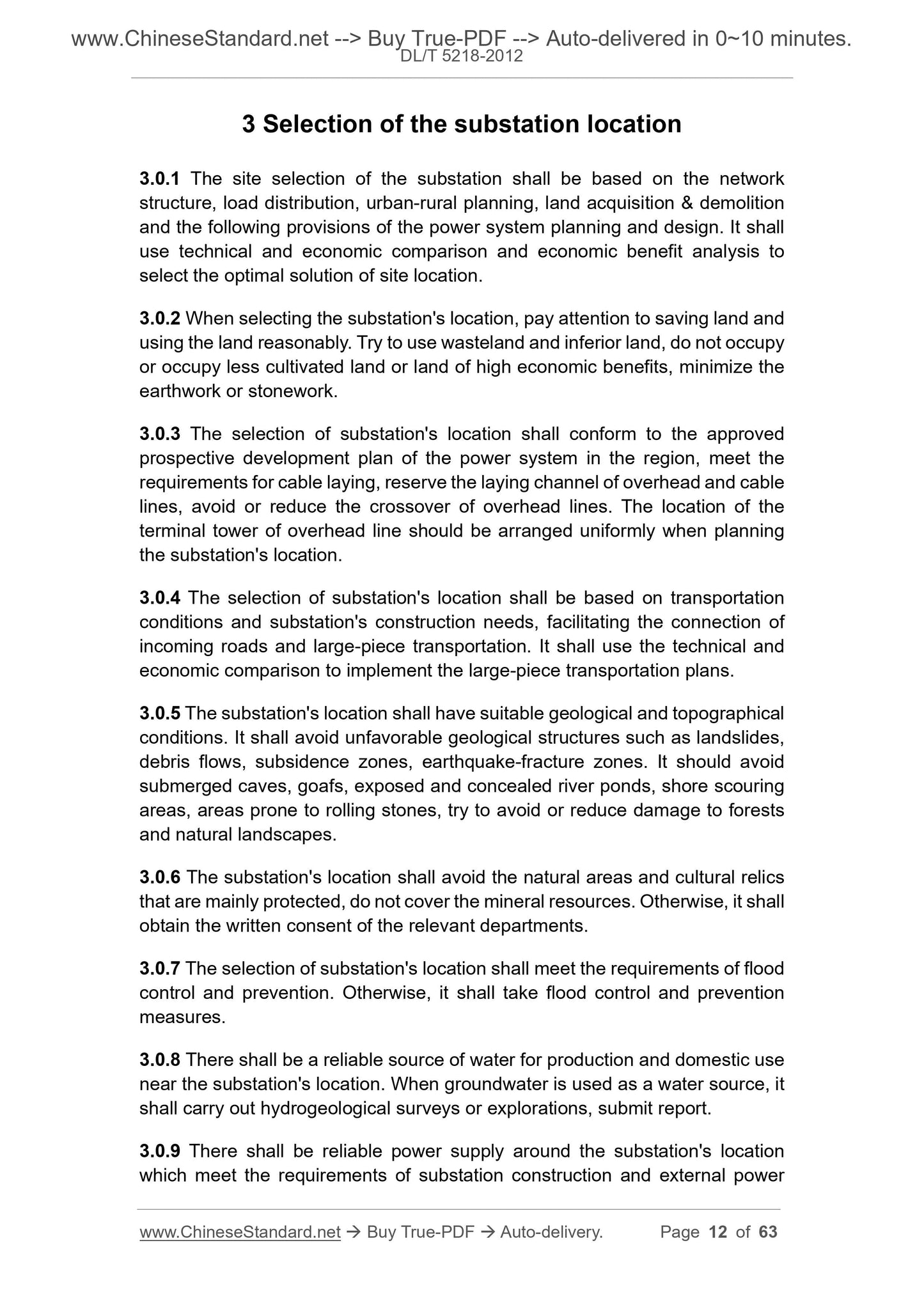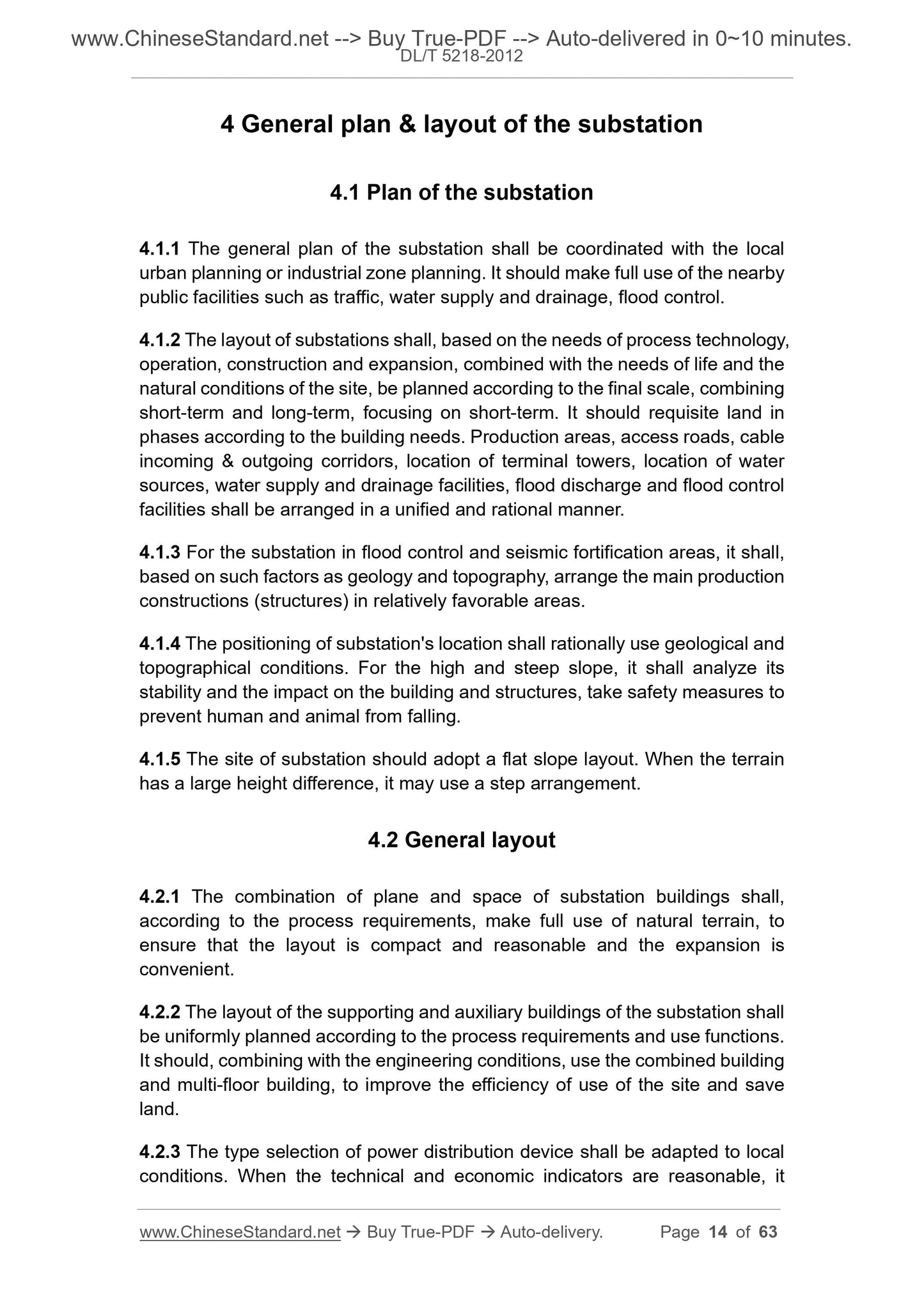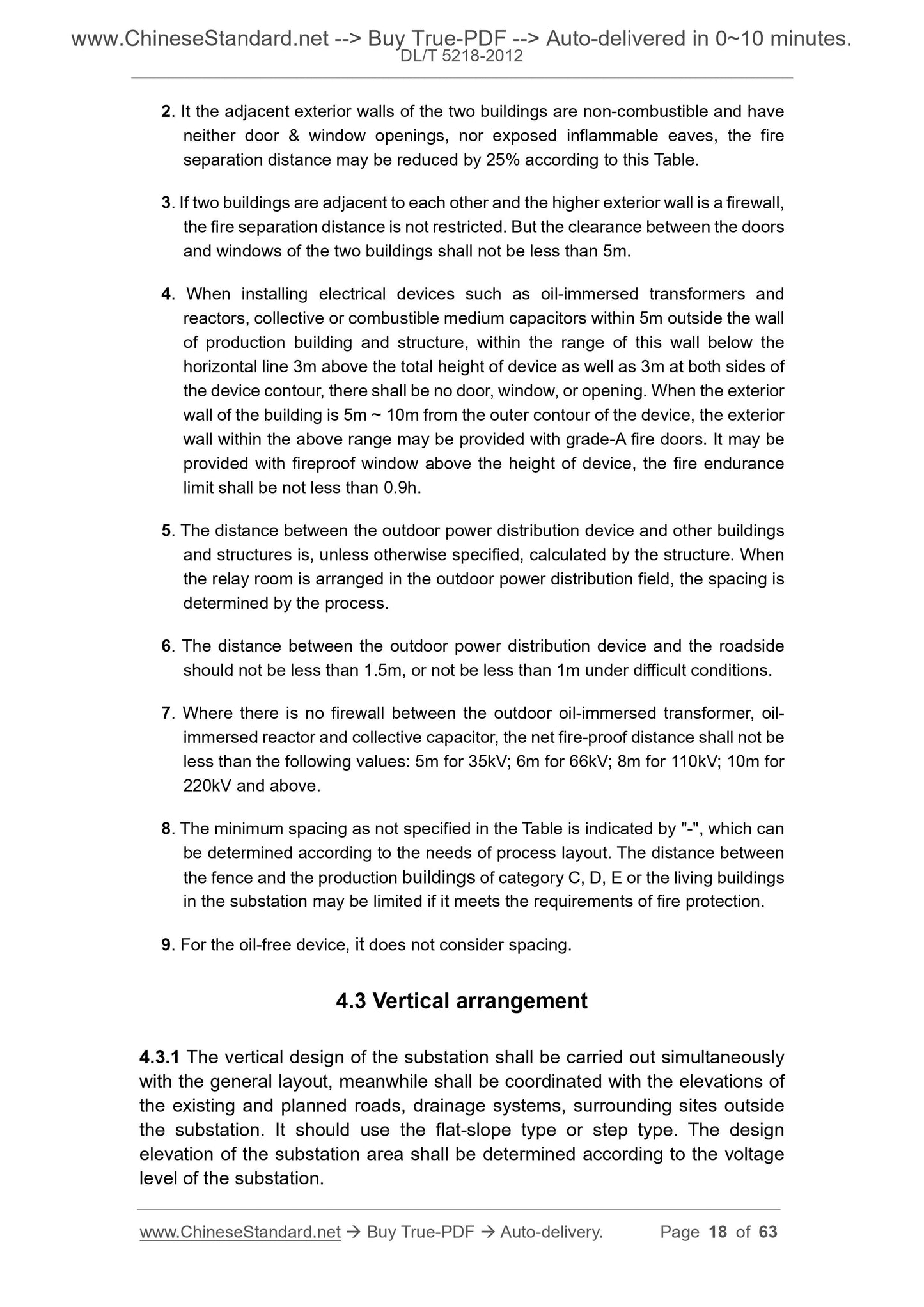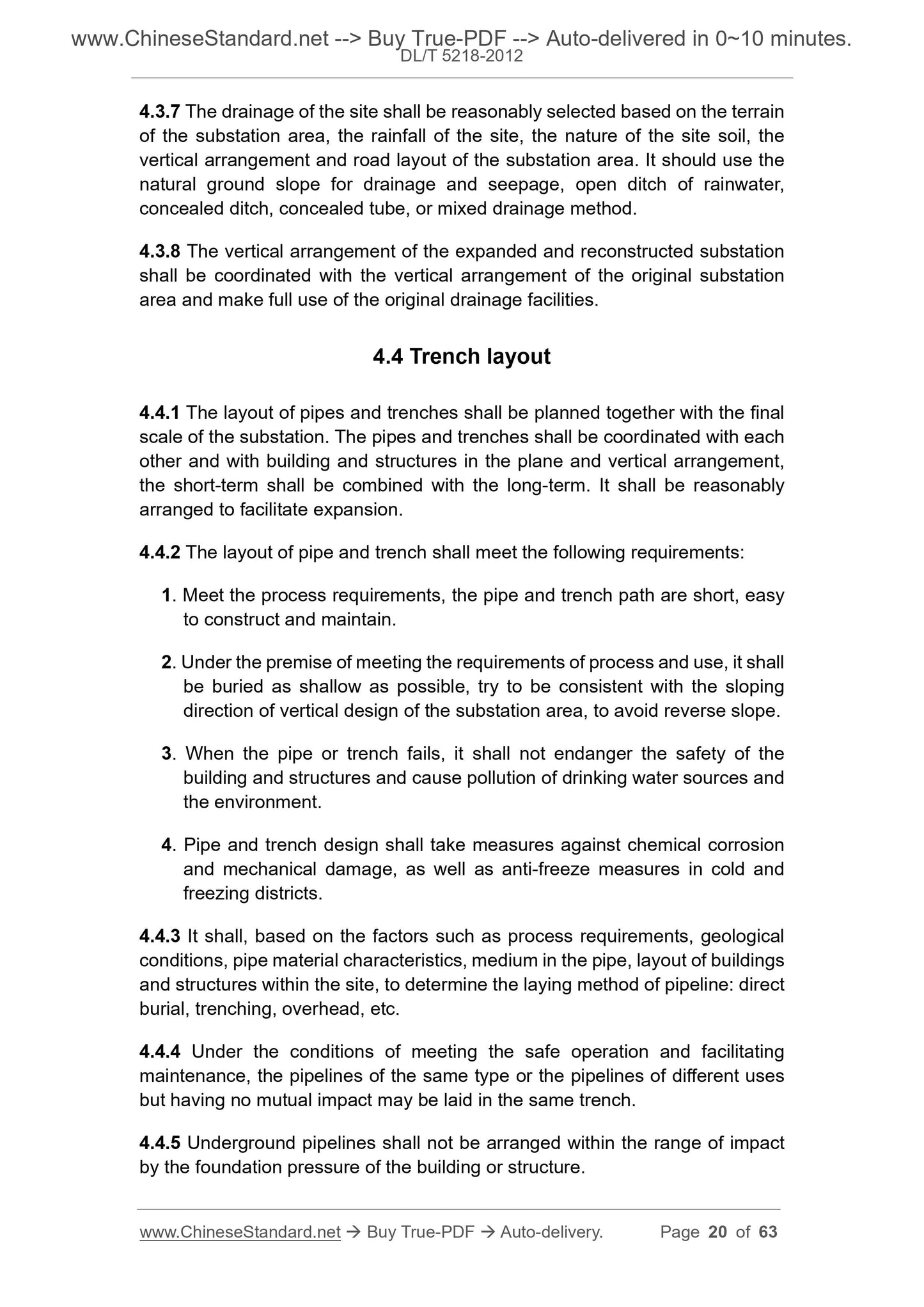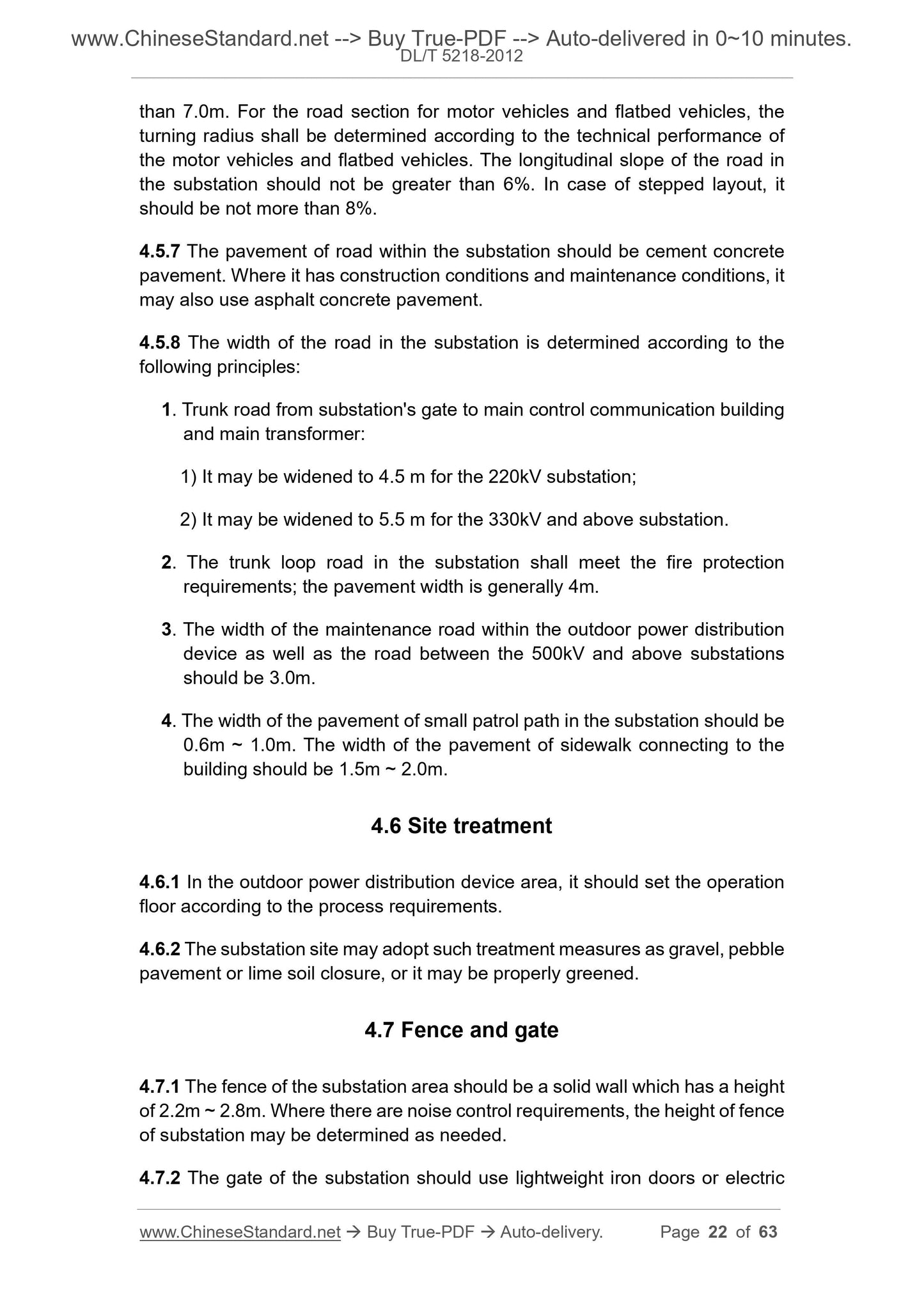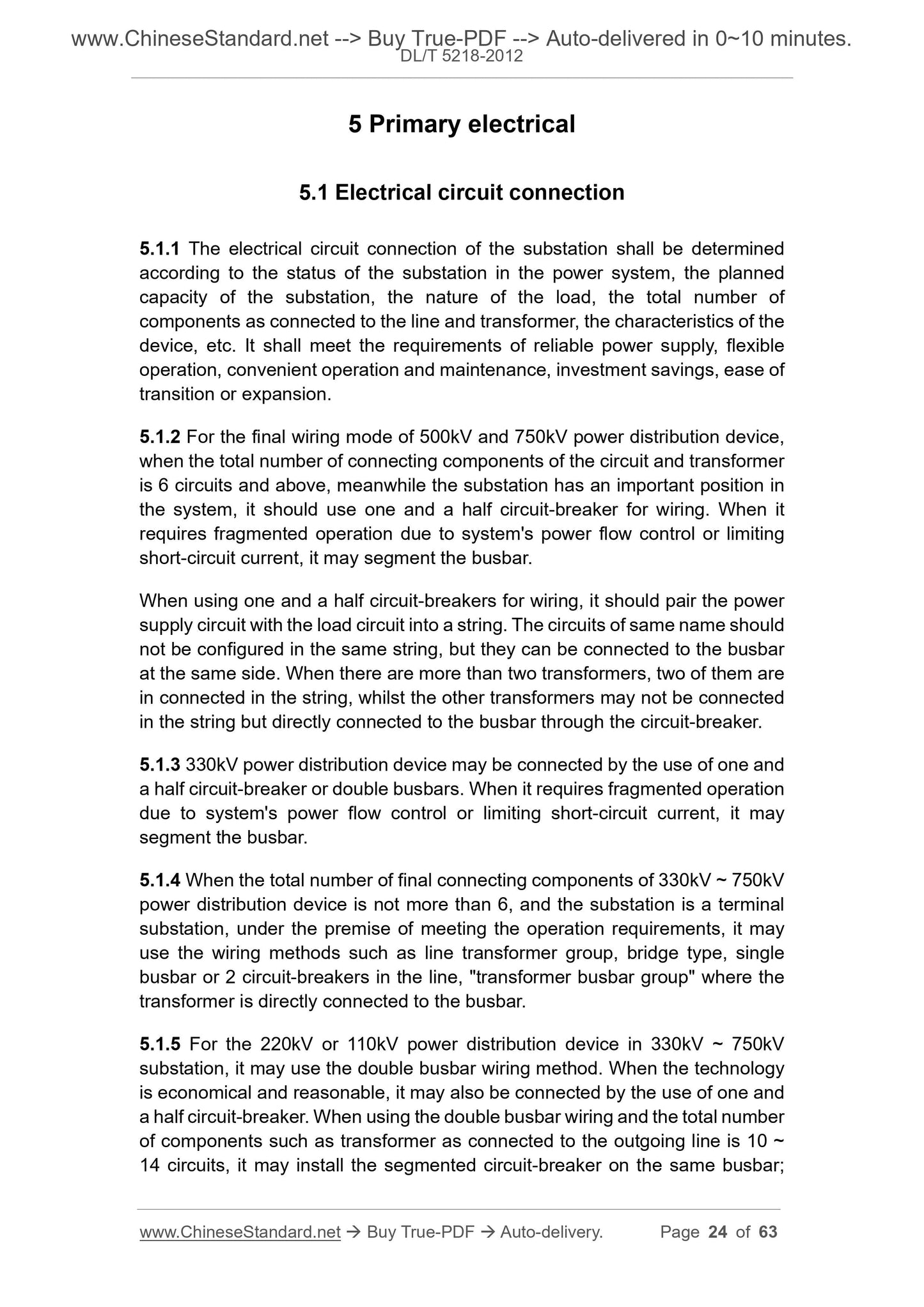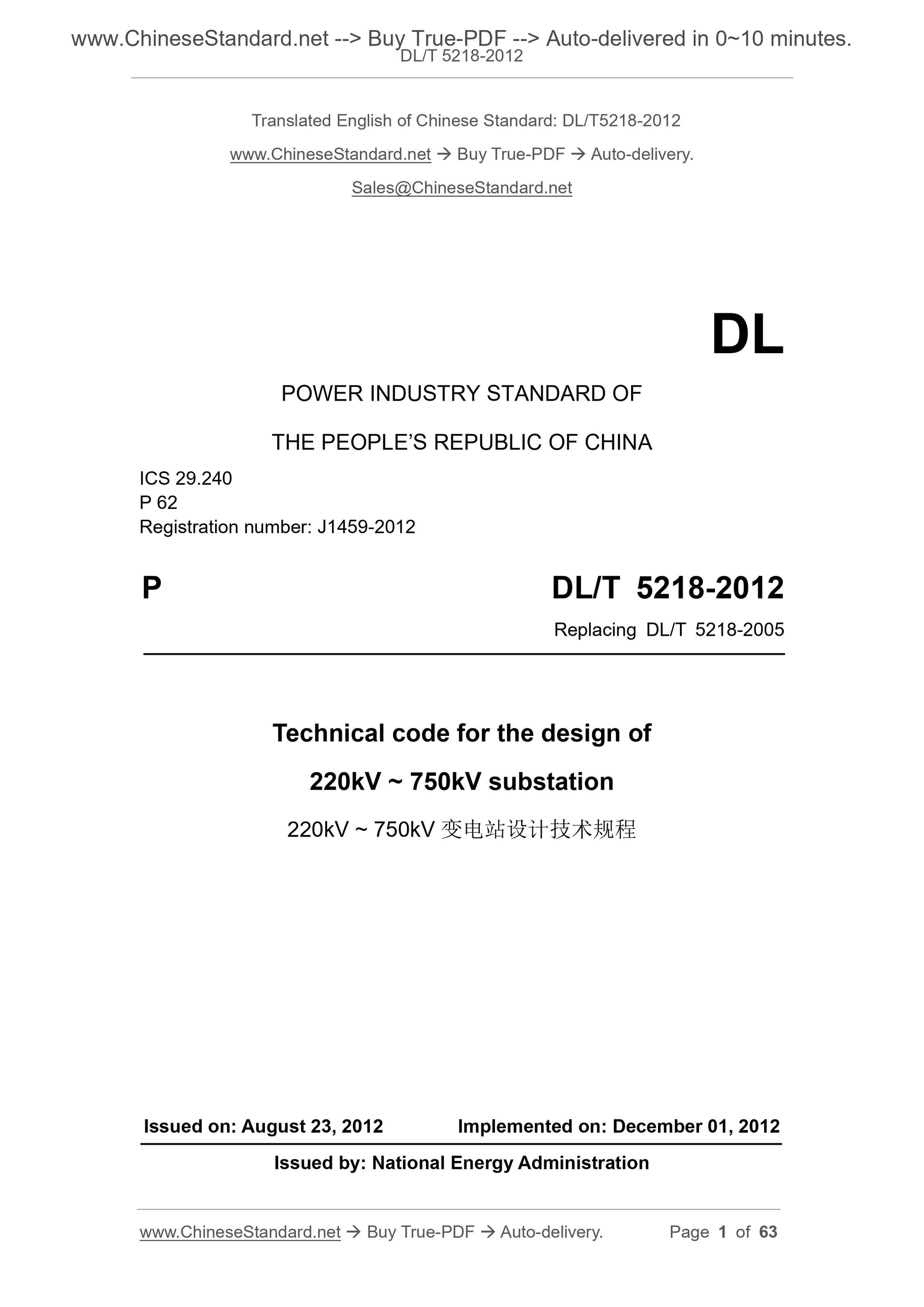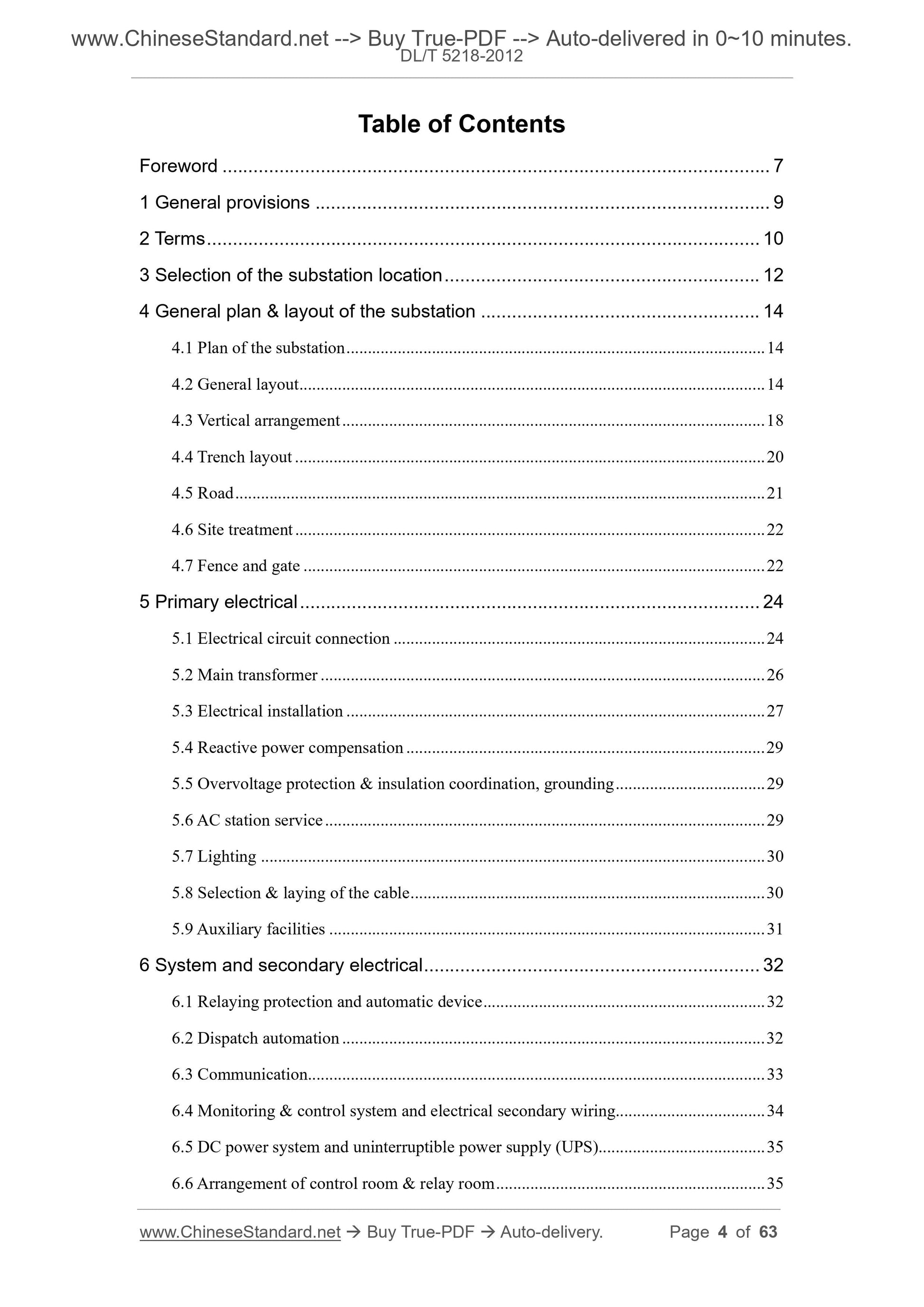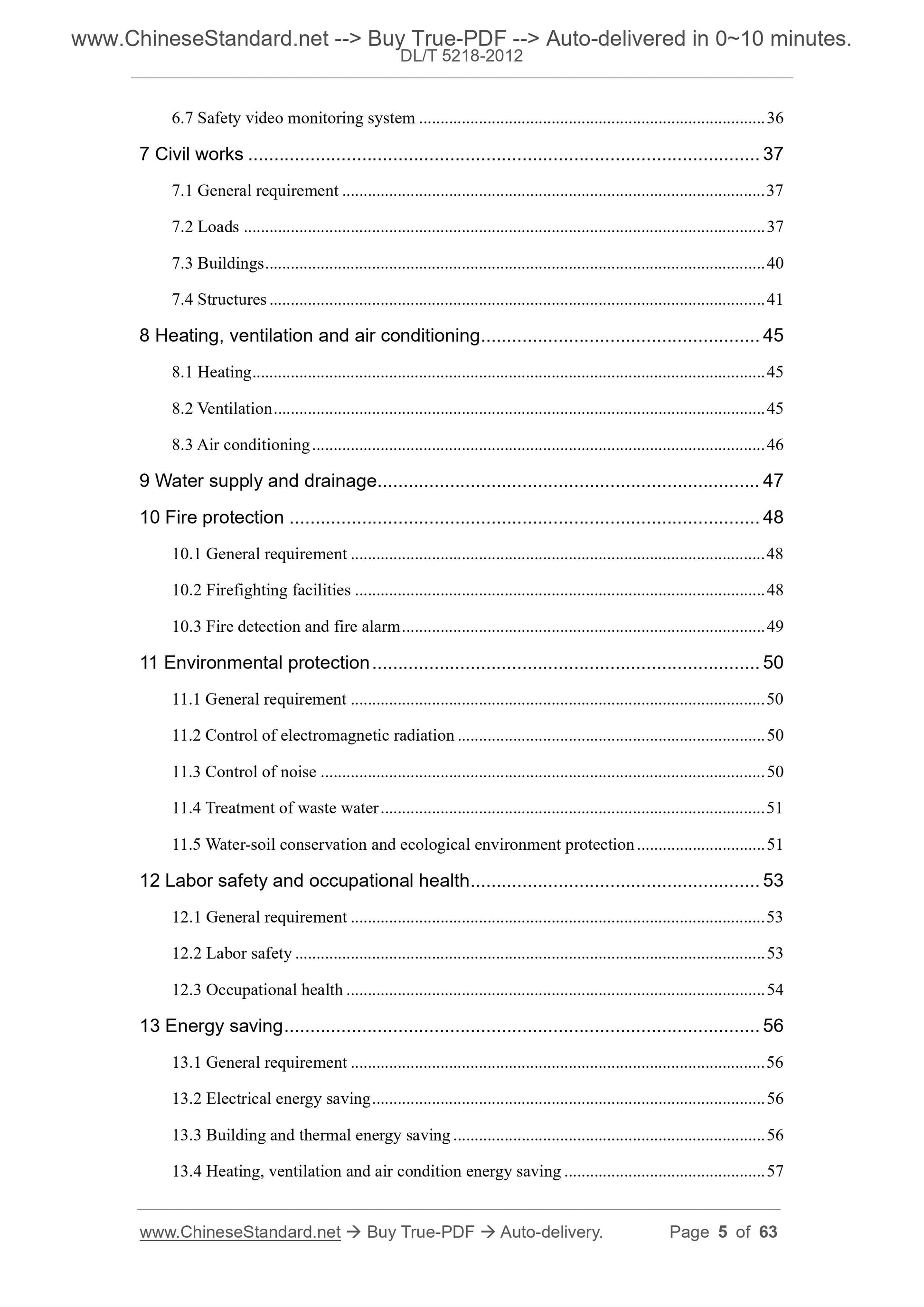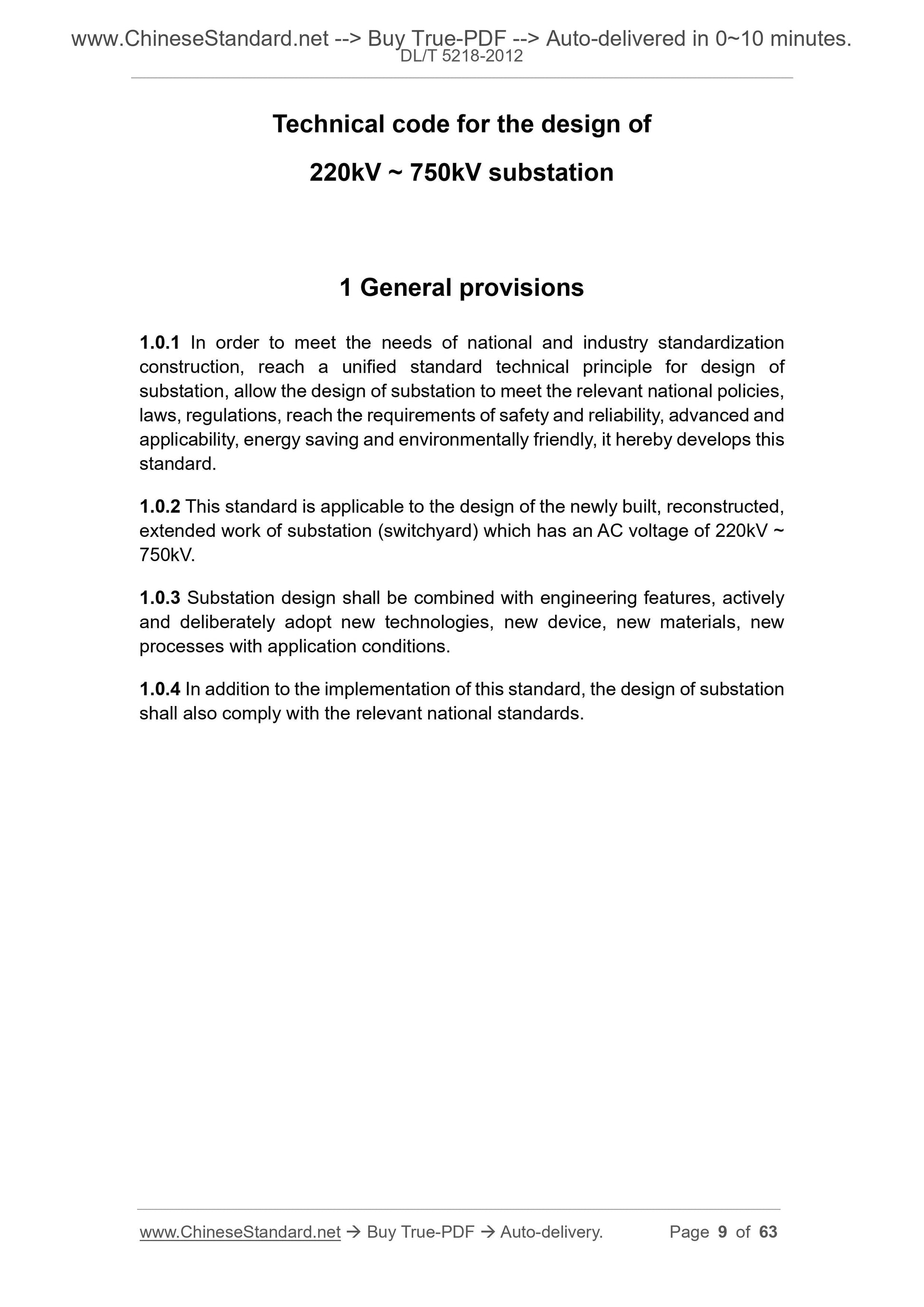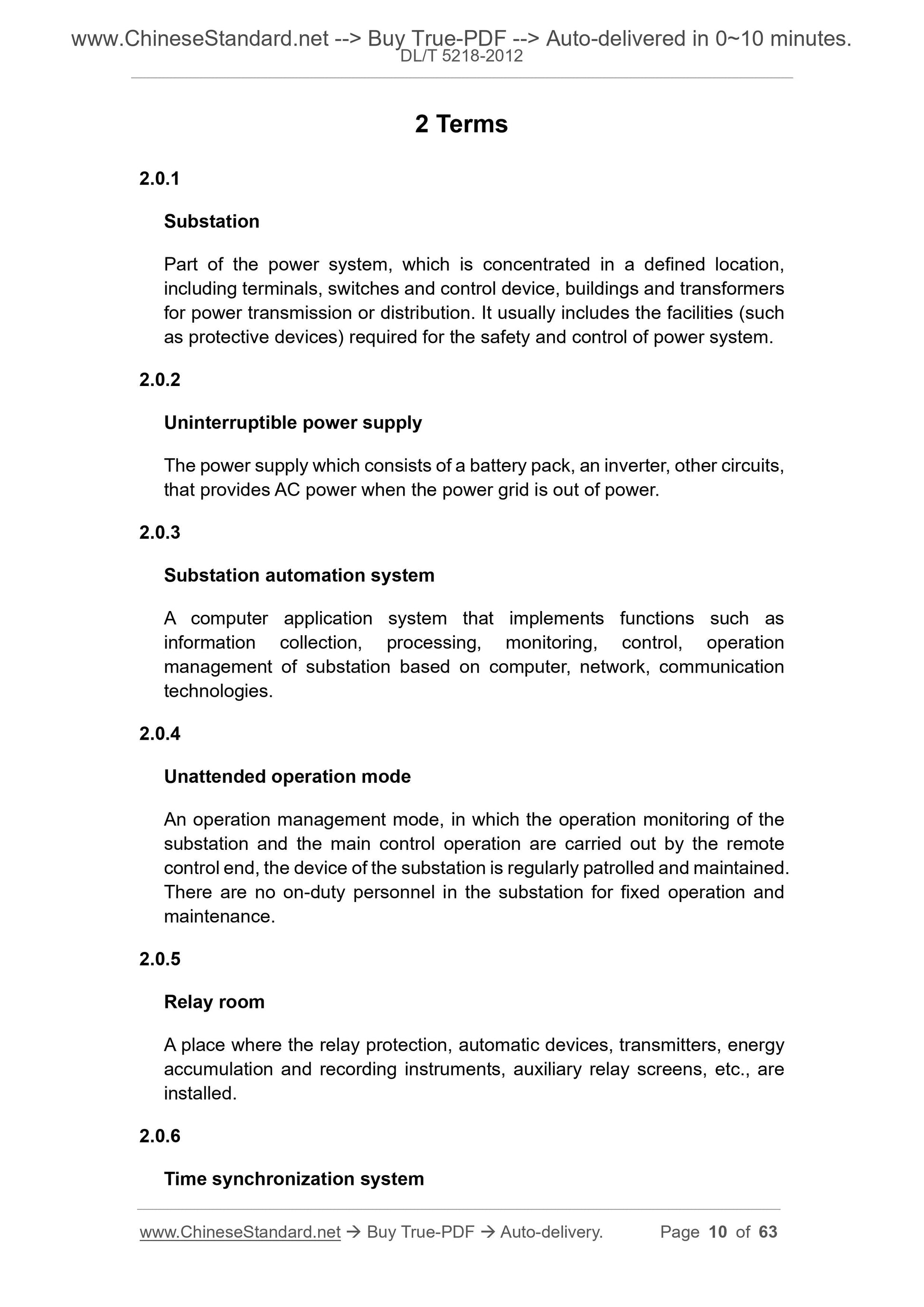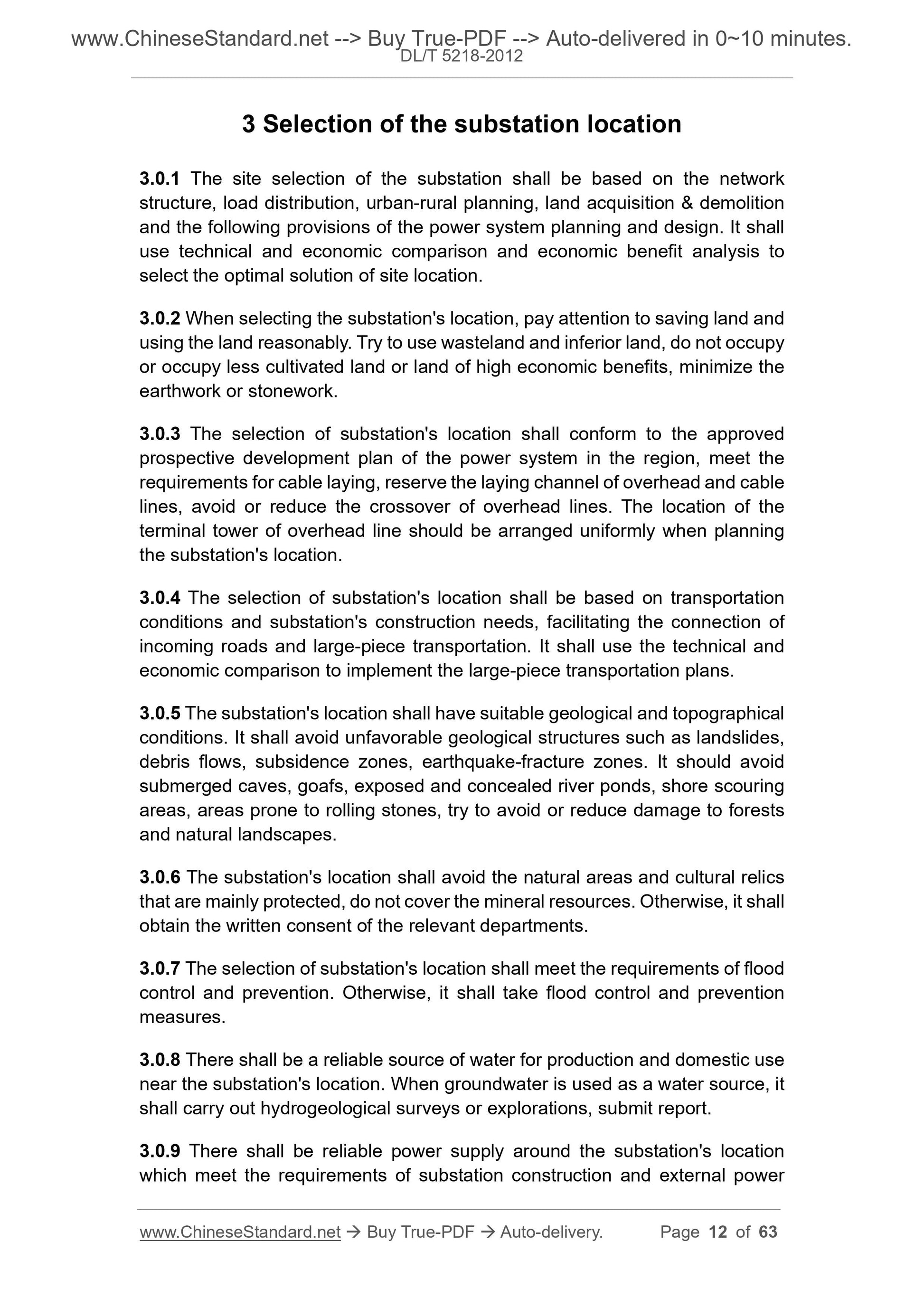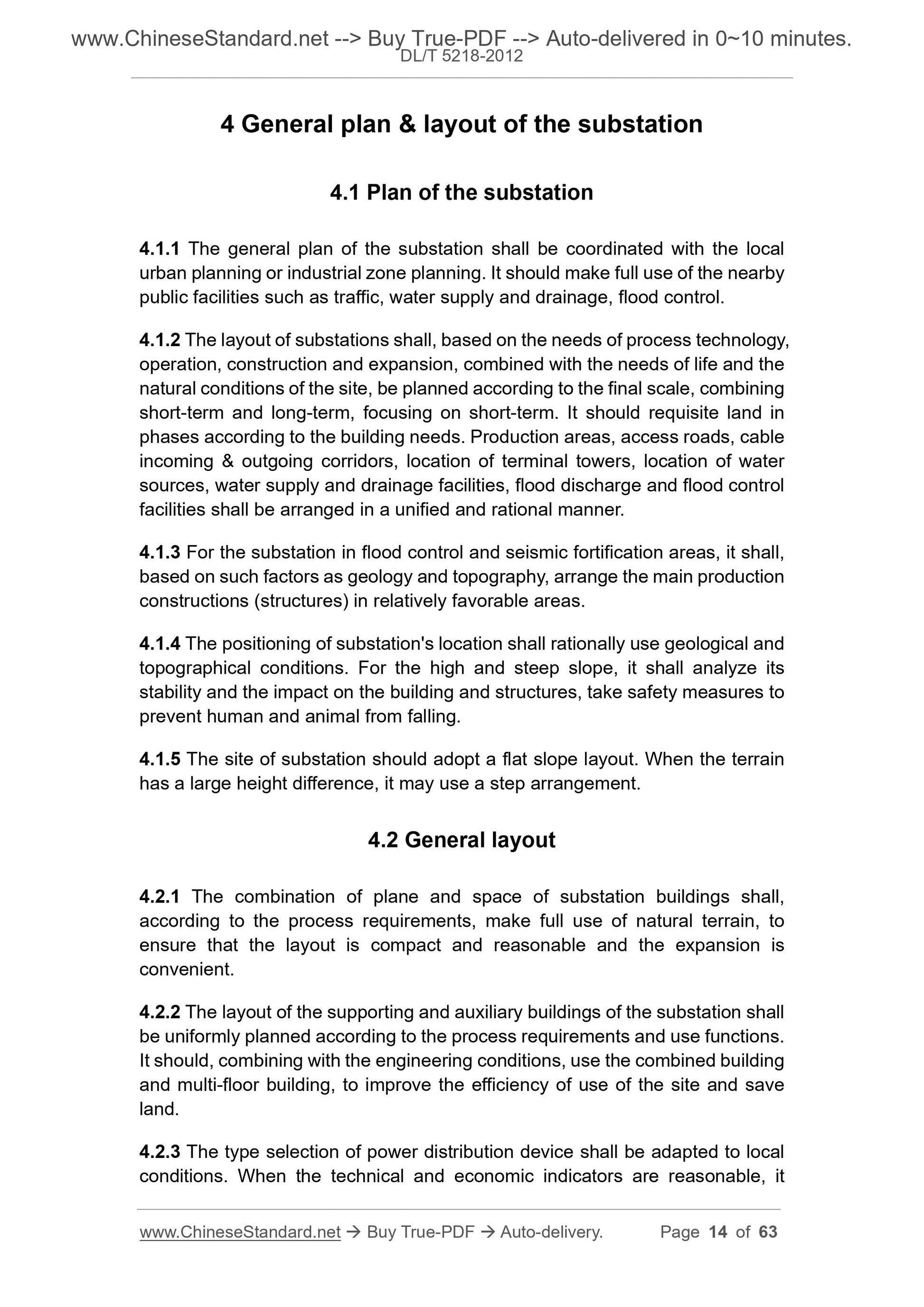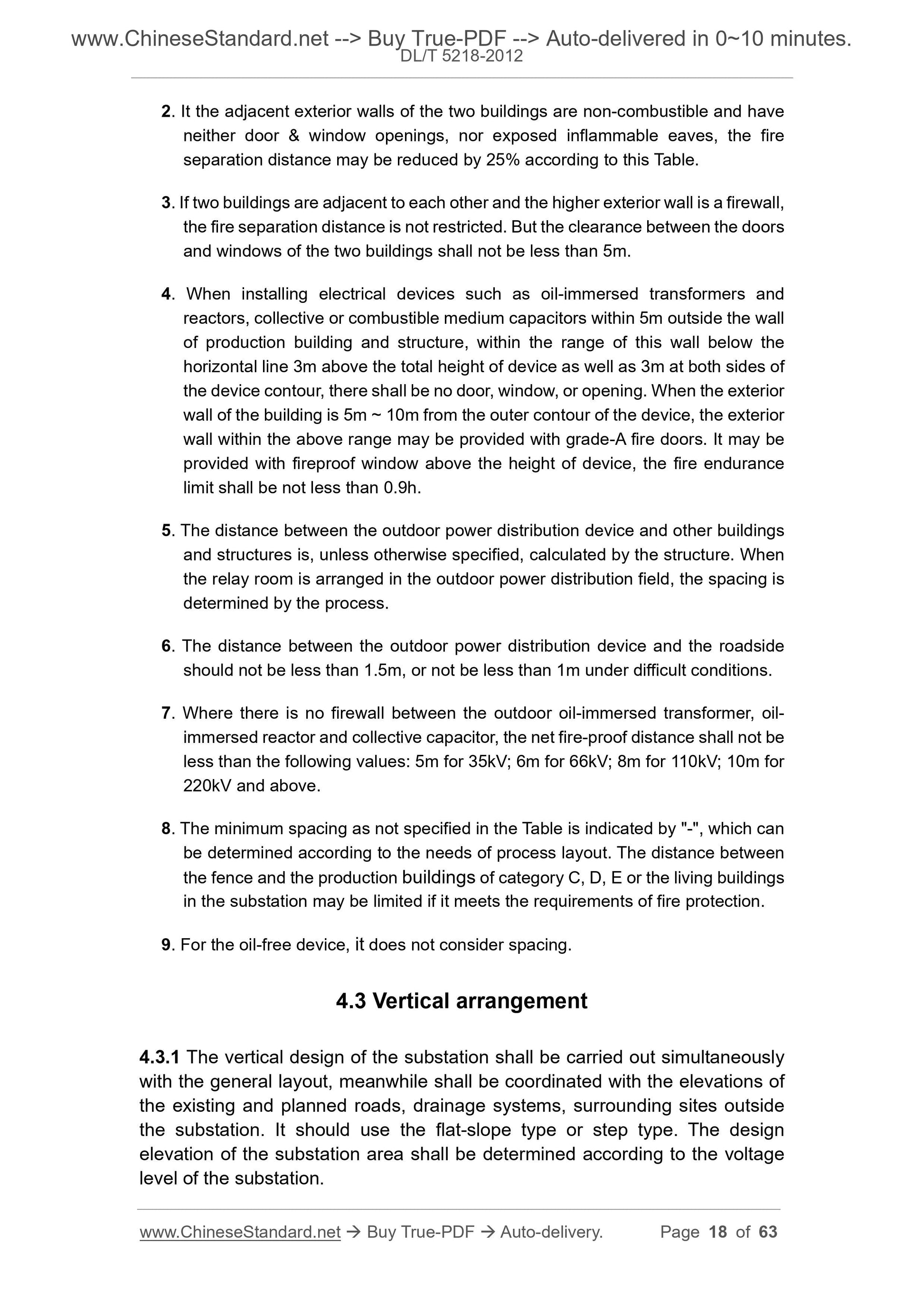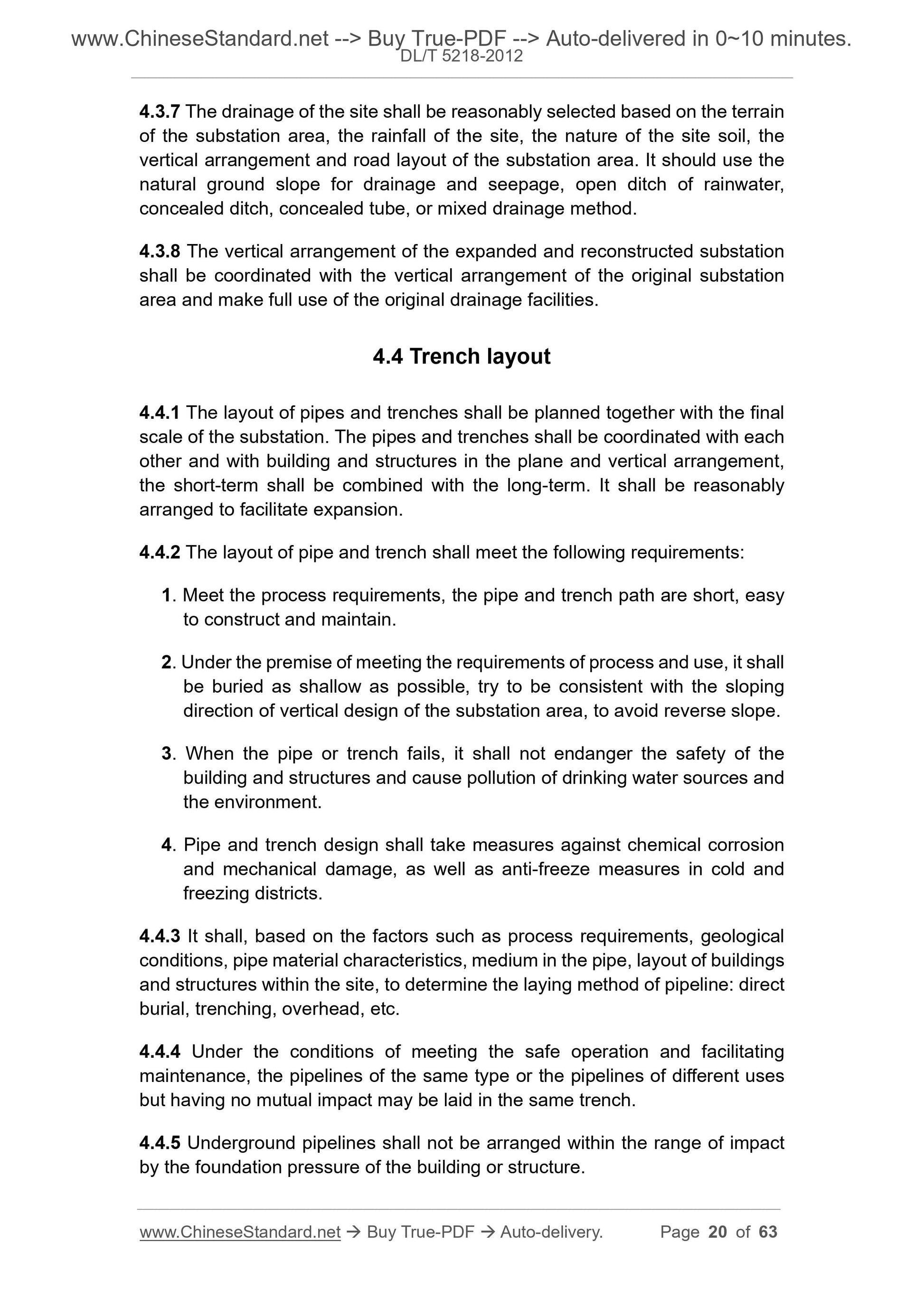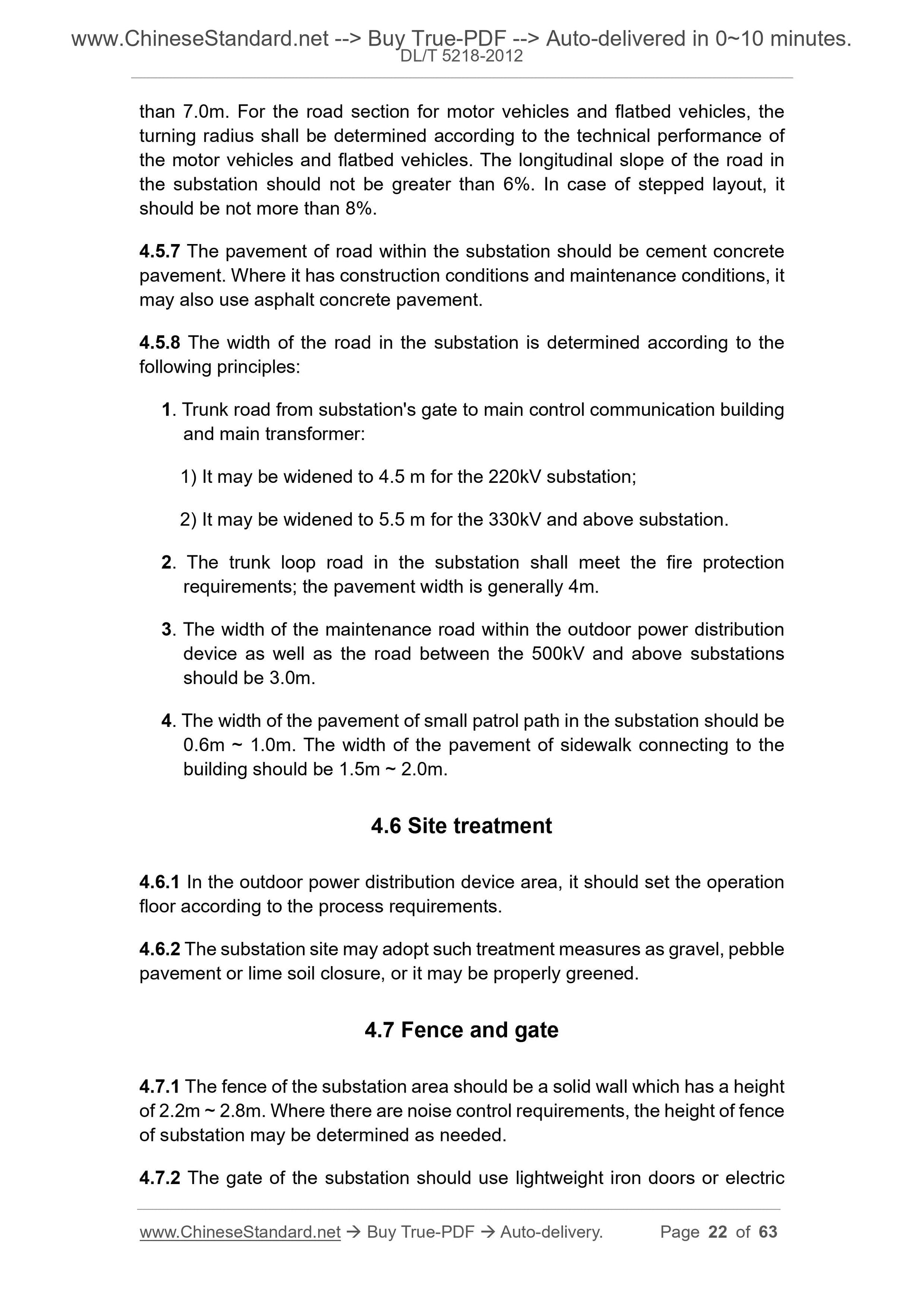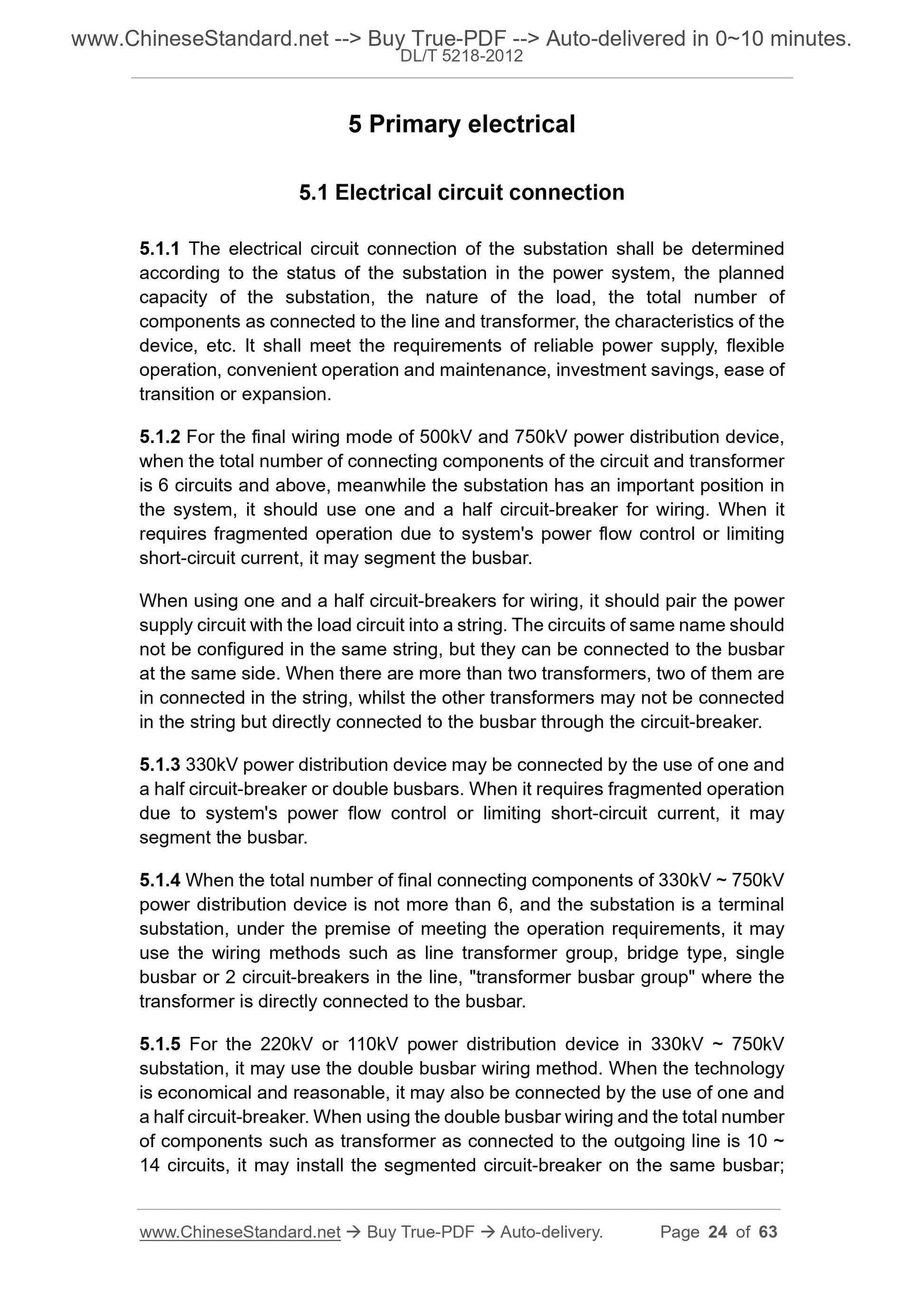1
/
의
12
PayPal, credit cards. Download editable-PDF and invoice in 1 second!
DL/T 5218-2012 English PDF (DLT5218-2012)
DL/T 5218-2012 English PDF (DLT5218-2012)
정가
$690.00 USD
정가
할인가
$690.00 USD
단가
/
단위
배송료는 결제 시 계산됩니다.
픽업 사용 가능 여부를 로드할 수 없습니다.
Delivery: 3 seconds. Download true-PDF + Invoice.
Get QUOTATION in 1-minute: Click DL/T 5218-2012
Historical versions: DL/T 5218-2012
Preview True-PDF (Reload/Scroll if blank)
DL/T 5218-2012: Technical code for the design of 220kV~750kV substation
DL/T 5218-2012
POWER INDUSTRY STANDARD OF
THE PEOPLE’S REPUBLIC OF CHINA
ICS 29.240
P 62
Registration number: J1459-2012
P DL/T 5218-2012
Replacing DL/T 5218-2005
Technical code for the design of
220kV ~ 750kV substation
ISSUED ON: AUGUST 23, 2012
IMPLEMENTED ON: DECEMBER 01, 2012
Issued by: National Energy Administration
Table of Contents
Foreword ... 7
1 General provisions ... 9
2 Terms ... 10
3 Selection of the substation location ... 12
4 General plan and layout of the substation ... 14
4.1 Plan of the substation ... 14
4.2 General layout ... 14
4.3 Vertical arrangement ... 18
4.4 Trench layout ... 20
4.5 Road ... 21
4.6 Site treatment ... 22
4.7 Fence and gate ... 22
5 Primary electrical ... 24
5.1 Electrical circuit connection ... 24
5.2 Main transformer ... 26
5.3 Electrical installation ... 27
5.4 Reactive power compensation ... 29
5.5 Overvoltage protection and insulation coordination, grounding ... 29
5.6 AC station service ... 29
5.7 Lighting ... 30
5.8 Selection and laying of the cable ... 30
5.9 Auxiliary facilities ... 31
6 System and secondary electrical ... 32
6.1 Relaying protection and automatic device ... 32
6.2 Dispatch automation ... 32
6.3 Communication ... 33
6.4 Monitoring and control system and electrical secondary wiring ... 34
6.5 DC power system and uninterruptible power supply (UPS) ... 35
6.6 Arrangement of control room and relay room ... 35
6.7 Safety video monitoring system ... 36
7 Civil works ... 37
7.1 General requirement ... 37
7.2 Loads ... 37
7.3 Buildings ... 40
7.4 Structures ... 41
8 Heating, ventilation and air conditioning ... 45
8.1 Heating ... 45
8.2 Ventilation ... 45
8.3 Air conditioning ... 46
9 Water supply and drainage ... 47
10 Fire protection ... 48
10.1 General requirement ... 48
10.2 Firefighting facilities ... 48
10.3 Fire detection and fire alarm ... 49
11 Environmental protection ... 50
11.1 General requirement ... 50
11.2 Control of electromagnetic radiation ... 50
11.3 Control of noise ... 50
11.4 Treatment of waste water ... 51
11.5 Water-soil conservation and ecological environment protection ... 51
12 Labor safety and occupational health ... 53
12.1 General requirement ... 53
12.2 Labor safety ... 53
12.3 Occupational health ... 54
13 Energy saving ... 56
13.1 General requirement ... 56
13.2 Electrical energy saving ... 56
13.3 Building and thermal energy saving ... 56
13.4 Heating, ventilation and air condition energy saving ... 57
13.5 Water saving ... 58
Explanations of wording in this standard ... 59
List of quoted standards ... 60
Technical code for the design of
220kV ~ 750kV substation
1 General provisions
1.0.1 In order to meet the needs of national and industry standardization
construction, reach a unified standard technical principle for design of
substation, allow the design of substation to meet the relevant national policies,
laws, regulations, reach the requirements of safety and reliability, advanced and
applicability, energy saving and environmentally friendly, it hereby develops this
standard.
1.0.2 This standard is applicable to the design of the newly built, reconstructed,
extended work of substation (switchyard) which has an AC voltage of 220kV ~
750kV.
1.0.3 Substation design shall be combined with engineering features, actively
and deliberately adopt new technologies, new device, new materials, new
processes with application conditions.
1.0.4 In addition to the implementation of this standard, the design of substation
shall also comply with the relevant national standards.
2 Terms
2.0.1
Substation
Part of the power system, which is concentrated in a defined location,
including terminals, switches and control device, buildings and transformers
for power transmission or distribution. It usually includes the facilities (such
as protective devices) required for the safety and control of power system.
2.0.2
Uninterruptible power supply
The power supply which consists of a battery pack, an inverter, other circuits,
that provides AC power when the power grid is out of power.
2.0.3
Substation automation system
A computer application system that implements functions such as
information collection, processing, monitoring, control, operation
management of substation based on computer, network, communication
technologies.
2.0.4
Unattended operation mode
An operation management mode, in which the operation monitoring of the
substation and the main control operation are carried out by the remote
control end, the device of the substation is regularly patrolled and maintained.
There are no on-duty personnel in the substation for fixed operation and
maintenance.
2.0.5
Relay room
A place where the relay protection, automatic devices, transmitters, energy
accumulation and recording instruments, auxiliary relay screens, etc., are
installed.
2.0.6
Time synchronization system
3 Selection of the substation location
3.0.1 The site selection of the substation shall be based on the network
structure, load distribution, urban-rural planning, land acquisition and demolition
and the following provisions of the power system planning and design. It shall
use technical and economic comparison and economic benefit analysis to
select the optimal solution of site location.
3.0.2 When selecting the substation's location, pay attention to saving land and
using the land reasonably. Try to use wasteland and inferior land, do not occupy
or occupy less cultivated land or land of high economic benefits, minimize the
earthwork or stonework.
3.0.3 The selection of substation's location shall conform to the approved
prospective development plan of the power system in the region, meet the
requirements for cable laying, reserve the laying channel of overhead and cable
lines, avoid or reduce the crossover of overhead lines. The location of the
terminal tower of overhead line should be arranged uniformly when planning
the substation's location.
3.0.4 The selection of substation's location shall be based on transportation
conditions and substation's construction needs, facilitating the connection of
incoming roads and large-piece transportation. It shall use the technical and
economic comparison to implement the large-piece transportation plans.
3.0.5 The substation's location shall have suitable geological and topographical
conditions. It shall avoid unfavorable geological structures such as landslides,
debris flows, subsidence zones, earthquake-fracture zones. It should avoid
submerged caves, goafs, exposed and concealed river ponds, shore scouring
areas, areas prone to rolling stones, try to avoid or reduce damage to forests
and natural landscapes.
3.0.6 The substation's location shall avoid the natural areas and cultural relics
that are mainly protected, do not cover the mineral resources. Otherwise, it shall
obtain the written consent of the relevant departments.
3.0.7 The selection of substation's location shall meet the requirements of flood
control and prevention. Otherwise, it shall take flood control and prevention
measures.
3.0.8 There shall be a reliable source of water for production and domestic use
near the substation's location. When groundwater is used as a water source, it
...
Get QUOTATION in 1-minute: Click DL/T 5218-2012
Historical versions: DL/T 5218-2012
Preview True-PDF (Reload/Scroll if blank)
DL/T 5218-2012: Technical code for the design of 220kV~750kV substation
DL/T 5218-2012
POWER INDUSTRY STANDARD OF
THE PEOPLE’S REPUBLIC OF CHINA
ICS 29.240
P 62
Registration number: J1459-2012
P DL/T 5218-2012
Replacing DL/T 5218-2005
Technical code for the design of
220kV ~ 750kV substation
ISSUED ON: AUGUST 23, 2012
IMPLEMENTED ON: DECEMBER 01, 2012
Issued by: National Energy Administration
Table of Contents
Foreword ... 7
1 General provisions ... 9
2 Terms ... 10
3 Selection of the substation location ... 12
4 General plan and layout of the substation ... 14
4.1 Plan of the substation ... 14
4.2 General layout ... 14
4.3 Vertical arrangement ... 18
4.4 Trench layout ... 20
4.5 Road ... 21
4.6 Site treatment ... 22
4.7 Fence and gate ... 22
5 Primary electrical ... 24
5.1 Electrical circuit connection ... 24
5.2 Main transformer ... 26
5.3 Electrical installation ... 27
5.4 Reactive power compensation ... 29
5.5 Overvoltage protection and insulation coordination, grounding ... 29
5.6 AC station service ... 29
5.7 Lighting ... 30
5.8 Selection and laying of the cable ... 30
5.9 Auxiliary facilities ... 31
6 System and secondary electrical ... 32
6.1 Relaying protection and automatic device ... 32
6.2 Dispatch automation ... 32
6.3 Communication ... 33
6.4 Monitoring and control system and electrical secondary wiring ... 34
6.5 DC power system and uninterruptible power supply (UPS) ... 35
6.6 Arrangement of control room and relay room ... 35
6.7 Safety video monitoring system ... 36
7 Civil works ... 37
7.1 General requirement ... 37
7.2 Loads ... 37
7.3 Buildings ... 40
7.4 Structures ... 41
8 Heating, ventilation and air conditioning ... 45
8.1 Heating ... 45
8.2 Ventilation ... 45
8.3 Air conditioning ... 46
9 Water supply and drainage ... 47
10 Fire protection ... 48
10.1 General requirement ... 48
10.2 Firefighting facilities ... 48
10.3 Fire detection and fire alarm ... 49
11 Environmental protection ... 50
11.1 General requirement ... 50
11.2 Control of electromagnetic radiation ... 50
11.3 Control of noise ... 50
11.4 Treatment of waste water ... 51
11.5 Water-soil conservation and ecological environment protection ... 51
12 Labor safety and occupational health ... 53
12.1 General requirement ... 53
12.2 Labor safety ... 53
12.3 Occupational health ... 54
13 Energy saving ... 56
13.1 General requirement ... 56
13.2 Electrical energy saving ... 56
13.3 Building and thermal energy saving ... 56
13.4 Heating, ventilation and air condition energy saving ... 57
13.5 Water saving ... 58
Explanations of wording in this standard ... 59
List of quoted standards ... 60
Technical code for the design of
220kV ~ 750kV substation
1 General provisions
1.0.1 In order to meet the needs of national and industry standardization
construction, reach a unified standard technical principle for design of
substation, allow the design of substation to meet the relevant national policies,
laws, regulations, reach the requirements of safety and reliability, advanced and
applicability, energy saving and environmentally friendly, it hereby develops this
standard.
1.0.2 This standard is applicable to the design of the newly built, reconstructed,
extended work of substation (switchyard) which has an AC voltage of 220kV ~
750kV.
1.0.3 Substation design shall be combined with engineering features, actively
and deliberately adopt new technologies, new device, new materials, new
processes with application conditions.
1.0.4 In addition to the implementation of this standard, the design of substation
shall also comply with the relevant national standards.
2 Terms
2.0.1
Substation
Part of the power system, which is concentrated in a defined location,
including terminals, switches and control device, buildings and transformers
for power transmission or distribution. It usually includes the facilities (such
as protective devices) required for the safety and control of power system.
2.0.2
Uninterruptible power supply
The power supply which consists of a battery pack, an inverter, other circuits,
that provides AC power when the power grid is out of power.
2.0.3
Substation automation system
A computer application system that implements functions such as
information collection, processing, monitoring, control, operation
management of substation based on computer, network, communication
technologies.
2.0.4
Unattended operation mode
An operation management mode, in which the operation monitoring of the
substation and the main control operation are carried out by the remote
control end, the device of the substation is regularly patrolled and maintained.
There are no on-duty personnel in the substation for fixed operation and
maintenance.
2.0.5
Relay room
A place where the relay protection, automatic devices, transmitters, energy
accumulation and recording instruments, auxiliary relay screens, etc., are
installed.
2.0.6
Time synchronization system
3 Selection of the substation location
3.0.1 The site selection of the substation shall be based on the network
structure, load distribution, urban-rural planning, land acquisition and demolition
and the following provisions of the power system planning and design. It shall
use technical and economic comparison and economic benefit analysis to
select the optimal solution of site location.
3.0.2 When selecting the substation's location, pay attention to saving land and
using the land reasonably. Try to use wasteland and inferior land, do not occupy
or occupy less cultivated land or land of high economic benefits, minimize the
earthwork or stonework.
3.0.3 The selection of substation's location shall conform to the approved
prospective development plan of the power system in the region, meet the
requirements for cable laying, reserve the laying channel of overhead and cable
lines, avoid or reduce the crossover of overhead lines. The location of the
terminal tower of overhead line should be arranged uniformly when planning
the substation's location.
3.0.4 The selection of substation's location shall be based on transportation
conditions and substation's construction needs, facilitating the connection of
incoming roads and large-piece transportation. It shall use the technical and
economic comparison to implement the large-piece transportation plans.
3.0.5 The substation's location shall have suitable geological and topographical
conditions. It shall avoid unfavorable geological structures such as landslides,
debris flows, subsidence zones, earthquake-fracture zones. It should avoid
submerged caves, goafs, exposed and concealed river ponds, shore scouring
areas, areas prone to rolling stones, try to avoid or reduce damage to forests
and natural landscapes.
3.0.6 The substation's location shall avoid the natural areas and cultural relics
that are mainly protected, do not cover the mineral resources. Otherwise, it shall
obtain the written consent of the relevant departments.
3.0.7 The selection of substation's location shall meet the requirements of flood
control and prevention. Otherwise, it shall take flood control and prevention
measures.
3.0.8 There shall be a reliable source of water for production and domestic use
near the substation's location. When groundwater is used as a water source, it
...
Share
